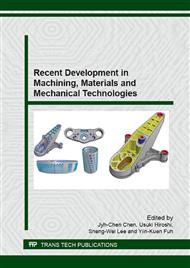p.468
p.473
p.479
p.484
p.490
p.496
p.500
p.509
p.515
Tensile Strength and Metallurgical Analysis in Anodized Al/Cu Joint Using Friction Stir Welding
Abstract:
Tensile strength, metallographic and structural analyses of anodized aluminum sheet–copper sheet dissimilar welds produced under various friction stir welding (FSW) conditions were conducted. The 6061 specimens were heated to 530~570 oC, held for 1 hour, followed by water quenching and furnace cooling. AA 6061-T6 Al sheets were anodized to thicknesses of 5μm and 12μm, respectively. FSW joints were characterized using microstructural analysis, microhardness measurements and tensile testing. The tensile strength of the 6061-T6/6061-T6 joint using FSW is 145 MPa. However, the tensile strength of the 6061-T6/Cu joint using FSW is decreased to 100 MPa. When the anodized layer was increased the tensile strength of the 6061-T6/Cu joint using FSW was decreased to a value below 50 MPa. Increasing the anodized layer thickness disturbed material mixing and the formation of increasing amounts of oxide rich structures. The oxide phase content and the mixed area homogeneity were increased with increasing layer thickness, decreasing the tensile strength of the FSW joints.
Info:
Periodical:
Pages:
490-495
Citation:
Online since:
July 2015
Authors:
Keywords:
Price:
Сopyright:
© 2015 Trans Tech Publications Ltd. All Rights Reserved
Share:
Citation:


